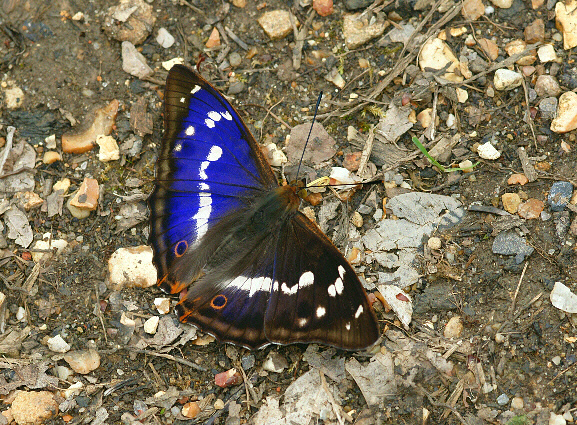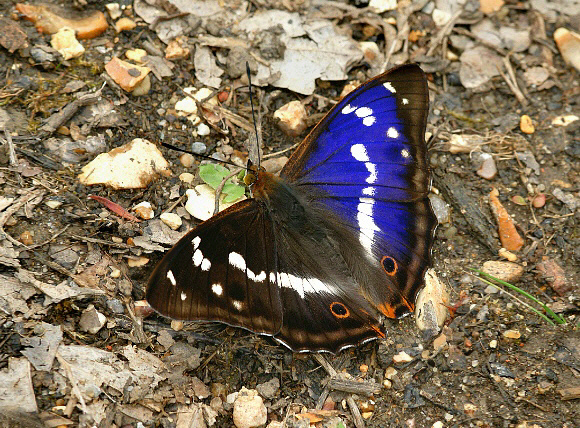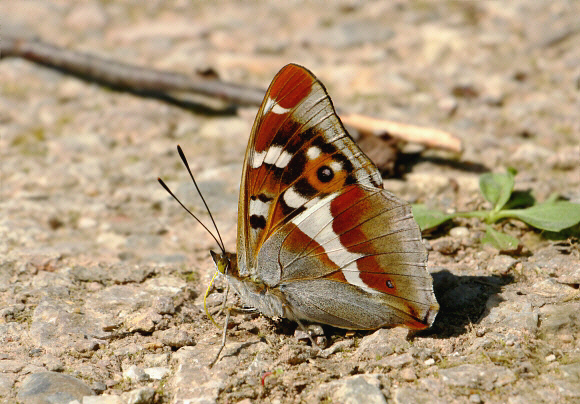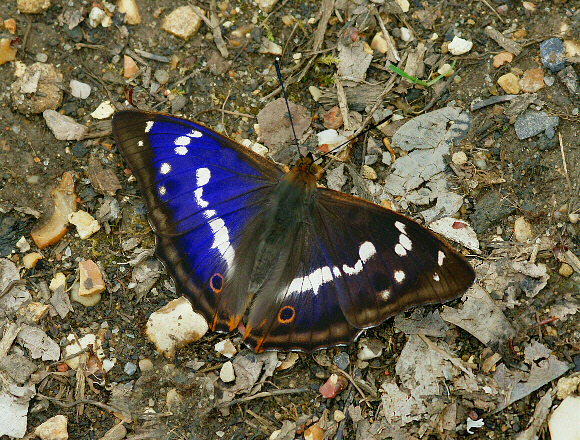
Purple Emperor Apatura iris male, Hampshire – Adrian Hoskins
Introduction
The magnificent Purple Emperor is undoubtedly the British butterfly most admired and most sought after by butterfly watchers, breeders, photographers and general naturalists alike. There are more stories told, and more myths about this species than any other.
It is the second-largest species in the UK ( the largest is the Swallowtail ), measuring up to 85mm across the wings. The deep purple-blue sheen on the wings of the male is produced structurally by light refracted by ridges on the wing scales. The colour is only visible from certain angles and under bright lighting conditions.
Less experienced butterfly watchers often mistake the White Admiral for this species. Both species are dark with white banding, both fly around oaks, and both fly at the same time of year. The White Admiral however is smaller, far more graceful and delicate in flight, has much more rounded wings, and lacks the purple sheen. In Europe it can be confused with its slightly smaller relative ilia, but that species has an orange-ringed black spot near the outer margin of the upperside forewing.
The Purple Emperor is distributed throughout much of central Europe but is localised and scarce in southern France, Spain and Portugal. It does not occur in Scandinavia, peninsular Italy or on any of the Mediterranean islands. Beyond Europe its range extends across temperate Asia from the Baltic states to north-east China and Korea.
 Purple Emperor Apatura iris male, Hampshire – Adrian Hoskins
Purple Emperor Apatura iris male, Hampshire – Adrian Hoskins
Habitats
In Britain the butterfly occurs as a breeding species in most of the larger woodlands in southern and central England, where the larval foodplant Salix grows along the edges of tracks. It once occurred over a wider area but it is now more local. In Wiltshire, Hampshire, Sussex and Surrey it occurs as a breeding species in almost all of the larger woodland complexes. The largest colonies are found in Rockingham Forest in Northamptonshire. A handful of isolated colonies also occur in Warwickshire, Herts, Oxfordshire, Buckinghamshire, Lincolnshire, Somerset and Devon.
Most colonies comprise of less than 20 adults per day at peak season, although in the East Midlands up to 30 can be seen in a single day under ideal conditions in certain forests. Individual butterflies have a range that probably encompasses several hectares, and is usually based on a single area of contiguous forest, with satellite colonies in adjacent smaller woodlands.
Both sexes can be found at least a kilometre away from the egg-laying localities, assembling at so-called master trees, of which there may be several in a large woodland complex. The master trees are usually mature oaks, but beeches, poplars and conifers are also used. In all cases the trees are tall specimens, often located on high ground, typically on the brow of a hill. At these trees the males indulge in spectacular ‘sorties’, competing for the best vantage points. Strings of 4 or 5 males can often be seen chasing in circles around the tree tops.
Females are seen less often. They visit the master trees to find mates, and thereafter disperse to the egg-laying sites, which are often on north facing woodland edges, or in semi-shaded and low-lying areas of the wood where there are high densities of sallow.
 Purple Emperor Apatura iris male, Hampshire – Adrian Hoskins
Purple Emperor Apatura iris male, Hampshire – Adrian Hoskins
Lifecycle
The conspicuous domed eggs are laid singly on the upperside of sallow leaves. The usual foodplant is broad-leaved sallow Salix caprea but the narrow-leaved S. cinerea is also sometimes used.
In July 2005 I watched a female which in the course of 3 or 4 minutes laid about 10 eggs at various heights between 2 and 5 metres on broad-leaved and narrow-leaved sallows growing on both sides of a track in a Wiltshire wood. The eggs were laid on semi-shaded leaves in the interior of the trees. At other sites in Hampshire and Surrey I have watched females ovipositing on low, sunlit leaves on woodland edge sallows; and at a thicket in north-east Hampshire I have seen a female oviposit at eye-level on a totally shaded broad-leaved sallow.
When first laid the eggs are pale green, but after about 5 days they develop a dark purplish band near the base. They hatch after about 14 days and the newly hatched larva makes it’s first meal of the eggshell.
The young larva is greyish-brown and has 2 prominent horns on its head. It feeds until October and then enters hibernation while in the 2nd or 3rd instar. It spends the winter resting on a silk pad spun on the upperside of a withered sallow leaf, or in the fork of a twig on the damper and shadier north or east facing side of the tree. It resumes feeding in early April.
When fully grown in mid-June the larva is plump and green. It is marked along the sides with dark-edged diagonal cream stripes that perfectly simulate the veins of a leaf. Two horns project forward from the head, and the body is strongly tapered at the tail. It is quite unlike that of any other British butterfly or moth.
The larva rests by daytime along the midrib on the upper surface of a leaf. It periodically nibbles at the tissue either side, leaving the midrib and leaf tip intact. At dusk it vacates it’s resting place and wanders all over the tree to feed. It lays a near-invisible trail of fine silk along its route, and uses this as a map to return to its ‘home’ leaf before dawn.
The chrysalis, which wriggles frantically like a wet fish if touched, is a beautiful shade of translucent silvery green, marked on the abdomen with short whitish diagonal dashes. It is slightly flattened in shape. The camouflage is so perfect that it is virtually impossible to locate, as it hangs suspended by the cremaster from a sallow leaf. The pupal stage lasts for about 14 days.
Adult behaviour
The butterflies begin emerging in late June and early July, although they tend to emerge a week or two later if the early summer has been cool. They remain on the wing until early August.
Purple Emperors spend most of their time resting high in trees, the males favouring oaks while the females more often rest in tall sallows. Females in particular may spend an hour or more on their tree-top perches, especially if the weather is cloudy or breezy. When the sun appears, even if only for a brief period, the males take flight and circle around the vicinity in search of food sources.
Both sexes will feed at aphid secretions which often coat the upper surface of sallow or oak leaves. They are also strongly attracted to sap runs. Males additionally feed at carrion, but are most often encountered when imbibing fluids from carnivore dung or urine-soaked ground. These provide them with essential alkaloids which are passed to females during copulation. Females are sometimes seen imbibing moisture from forest tracks between bouts of egg-laying, but do not visit carrion or dung.

Purple Emperor Apatura iris male, Hampshire – Adrian Hoskins
In July 1984 I found no less than 6 males feeding at the carcass of a roe deer that was floating in an open cesspit in a Hampshire thicket. The butterflies were so stupefied by their unsavoury meal that 2 of them remained on the carcass as I lassoed a rope around the antlers and hauled it to the edge of the cesspit to take photographs !
Mud-puddling and dung-feeding activity typically begins at about 8.30am on warm sunny mornings, or later if it is cooler or slightly overcast, and can continue until 12.30pm or later although there is usually a lull in activity between noon and 2pm. Sometimes a male will spend an hour or more on the ground without moving. Further puddling sometimes occurs in the late afternoon at about 6.00-7.00pm if it remains sunny.
In the early afternoon both sexes fly to the highest point in the forest – the ‘master tree’, typically a tall oak. As many as 6 or 7 may gather there on any particular day. Males usually arrive first, and soon begin to chase each other around in circles, competing to obtain the best ‘throne’ – usually a prominent clump of leaves on which they sit to await the arrival of the females.
When a female appears the dominant male charges after her, followed by any other males at the tree, and the butterflies fly in a string, one behind the other, following the female as she flits and glides around the upper branches. The strongest and most aggressive male eventually chases off his lesser rivals, and then follows the female until she settles on a sunlit clump of leaves, often half a kilometre or more distant from the master tree.
Copulation takes place there in early afternoon. The mating pair spend most of the remaining afternoon sitting on their love nest, but sometimes fly in tandem from one branch to another, or more rarely descend to ground level.
In July 1986 for example, while watching a mud-puddling male in a Surrey wood, I saw a copulated pair float down from an oak, and settle on gravel. When I approached they flew up into another tall oak, settling near the top of the tree. On another occasion I spotted a copulating pair late in the afternoon, at a height of about 6 meters in a spruce. The pair were still copulating at 7.00pm, when I had to leave, and I suspect that they remained joined until dusk, or possibly until the following morning.
In some years prolonged periods of dull or rainy weather occur during the flight season. Then when the sun does briefly appear, a frenzy of courtship, mating and egg-laying takes place. They are able to make the most of very limited opportunities, e.g. weather conditions during throughout the 2007 flight season in the UK were cool, overcast and often wet, with precious little time for mate location or egg laying.
Nevertheless 2008 and 2009 produced the highest Purple Emperor counts on record. Similarly in 2012 Britain experienced atrocious weather, with cool wet and windy conditions lasting from early May until late July. The weather then suddenly changed and became very hot and sunny for about a week, during which time the butterflies emerged en masse, and were able to lay a large number of eggs.
